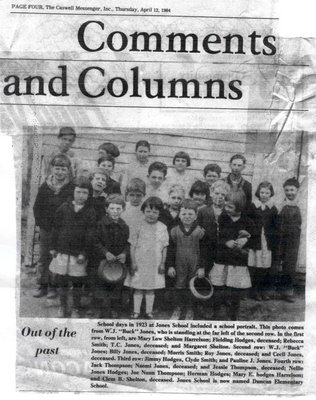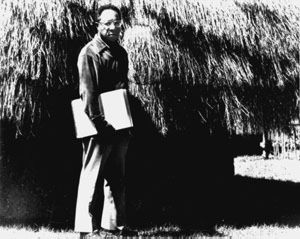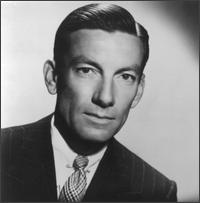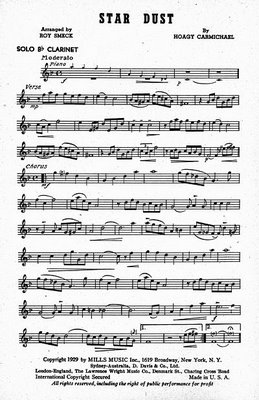
Photograph Identification Project Entry #4 (Solution)
On 28 June 2006, the CCHA posted the above photograph as
Photograph Identification Project Entry #4 and asked for help identifying the children. Click on the photograph for a larger image.
Fortunately, one viewer of the image recalled that it had been featured in the "Out of the Past" section of
The Caswell Messenger (Thursday, April 12, 1984), with the following caption:
School days in 1923 at Jones School included a school portrait. This photo comes from W. J. "Buck" Jones, who is standing at the far left of the second row. In the first row, from left, are Mary Low [Lou?] Shelton Harrelson; Fielding Hodges, deceased; Rebecca Smith; T. C. Jones, deceased; and Margaret Shelton. Second row: W. J. "Buck" Jones; Billy Jones, deceased; Morris Smith; Roy Jones, deceased; and Cecil Jones, deceased; Third row: Jimmy Hodges, Clyde Smith; and Pauline J. Jones. Fourth row: Jack Thompson; Naomi Jones, deceased; and Jessie Thompson, deceased; Nellie Jones Hodges; Joe Nunn Thompson; Herman Hodges; Mary E. Hodges Harrelson; and Clem B. Shelton, deceased.
The CCHA had identified this school as Cobb, but, based upon the above, and input from others it definitely was the one-room Jones School that was located on the farm of George Thomas Hodges (1871-1939). The school was on the Hodges Dairy Road a quarter mile east of George T. Hodges's store and across the road from the Hodges Home. The George Hodges-Thomas Smith House is featured on page 99 (Photo 100) of
An Inventory of Historic Architecture: Caswell County, North Carolina, Ruth Little-Stokes (1979). The school closed in 1930, and students were bussed to Cobb Memorial School that fall. The old one-room school building was demolished in the 1980's.
This school has been confused with the Jones School for black students that was located at the corner of Mineral Springs Road and Allison/White House Road. After desegregation this black Jones School was renamed Duncan School.
Also note that the year 1923 stated in the newspaper article probably is incorrect. This photograph most likely was taken a few years later. Also, some of the identifications in the newspaper require correction or amplification.
Here is a list of the names:
1. Mary Lou Shelton Harrelson, daughter of George H. and Elizabeth Nethery Shelton. She married Malcolm Harrelson and was the sister of Clem (#21 below, her older brother) and Margaret (#5 below). The 1920 US Census (Locust Hill, Caswell County) has entries for this family.
2. Fielding Hodges. This is the Fielding Jones Hodges who married Dorothy McKinney, but he would have been only four years in 1923, having been born 12 June 1919. This is one of the bases for concluding that the photograph was taken later than 1923. His parents were George Thomas Hodges and Mary Elizabeth Shelton. He was the brother of James Armistead Hodges (#11 below), Herman Hodges (#19 below), and Mary Evelyn Hodges (#20 below). The school was on their father's farm.
3. Rebecca Smith. The 1920 US Census (Locust Hill, Caswell County) shows William P. (age 32) and Annie Smith (age 30) with the following children: Eva (12); Clyde (5), Maurice (3); and Rebecca (six months). However, Smith family members are a bit troubled here. Notwithstanding the census information, they suggest that this Rebecca (#3), Morris (#8 below), and Clyde (#12 below) were the children of Felix Smith. The uncertainty is compounded by the absence in the photograph of the children of Thomas and Lottie Smith (Bertie, Wilbur, Steve, and Wesley), who lived in the community and were of the right age to attend the Jones School. Thus, it is possible that these three children have bee misidentified.
4. T. C. Jones. This is Thadeus Cornelius Jones II, the son of Paul Hosier Jones and Lemma Sue Fowlkes. He was born 14 September 1919 and died 17 March 1937. He is the brother of W. J. "Buck" Jones (#6 below) and never married. His birth year gives further support to the date of this photograph being later than 1923.
5. Margaret Shelton. She is the twin sister of Mary Lou Shelton (#1 above) and a sister of Clem Shelton (#21 below, her older brother). She never married. The 1920 US Censns (Locust Hill, Caswell County) shows a Magaret L. Shelton, age two, as the daughter of G. H. and Elizabeth Shelton.
6. W. J. "Buck" Jones. This is William Joseph (Buck) Jones, son of Paul Hosier Jones and Lemma Sue Fowlkes, and older brother of Thadeus Cornelius Jones II listed above. Buck Jones was born 5 July 1915 and died 8 July 2001. He married Mary Vivian Hodges 25 December 1937.
7. Billy Jones. This is Billie Webster Jones (1917-1970), son of Walter Raleigh Jones and Dora Belle Siddle. He was a first cousin of T. C. Jones and Buck Jones, listed above. He married Ann Daniel, who graduated from Cobb Memorial High School in 1941.
8. Morris Smith. The 1920 US Census (Locust Hill, Caswell County) shows William P. and Annie Smith with the following children: Eva (12); Clyde (5), Maurice (3); and Rebecca (six months). See the comments under Rebecca Smith (#3 above). This person may be mis-identified.
9. Roy Jones. This is Harry Leroy (Roy) Jones who married Mary C. Gunn (1916-2003). He was the son of Robert Leroy and Ruth Hatchett Jones and a brother of Cecil Jones (#10 below). His wife, Mary C. Gunn, was a sister of Thomas Earl (Tommy) Gunn, who married Anna Thelma Thompson, whose sister, Jessie Thompson, is listed below.
10. Cecil Jones. This is Cecil Owen Jones (1917-1943), son of Robert Leroy Jones and Ruth Hatchett. Thus, he is was a brother of Roy Jones (#9 above) and was killed in World War II.
11. Jimmy Hodges. This is James Armistead Hodges who married Nellie Jones (#17 below). He is the son of George Thomas Hodges and Mary Elizabeth Shelton and the brother of Fielding Hodges (#2 above), Herman Hodges (#19 below), and Mary Evelyn Hodges (#20 below). Note that the Jones School was located on the farm of George Thomas Hodges.
12. Clyde Smith. The 1920 US Census (Locust Hill, Caswell County) shows William P. and Annie Smith with the following children: Eva (12); Clyde (5), Maurice (3); and Rebecca (six months). However, see the comments above associated with Rececca Smith (#3).
13. Pauline J. Jones. She is Mary Pauline Jones (1917-1998), the daughter of Paul Hosier Jones and Lemma Sue Fowlkes. She would be the sister of Buck Jones and T. C. Jones, listed above. She married John M. Jones (no relation) of Reidsville, North Carolina.
14. Jack Thompson. He is the son of Joseph Hilton and Jennie Bell Nunn Thompson and the brother of Jessie Thompson (#17 below) and Joe Nunn Thompson (#18 below).
15. Naomi Jones. She is Naomi Jones (1911-1943) who was a daughter of Robert Henry Jones and Caroline Wimbish Bennett and a sister of Laura Mae Jones, who married Julius Spencer Watlington (owned and operated Watlington's on the Square in Yanceyville). She also is a sister of Nellie Jones Hodges (#17 below). Naomi Jones never married.
16. Jessie Thompson. This is Jessie Thompson, daughter of Joseph Hilton and Jennie Bell Nunn Thompson and the sister of Jack Thompson (#14 above) and Joe Nunn Thompson (#18 below).
17. Nellie Jones Hodges. She is Nellie Althea Jones, born 1913, who married James Armistead (Jimmy) Hodges, Sr. (#11 above). James A. Hodges, Sr. and Nellie Althea Jones were the parents of James A. Hodges, Jr., Alvis Hodges, Ann Hodges, and Mary Nell Hodges.
18. Joe Nunn Thompson. This Joseph Nunn Thompson (born 1914), who married Hattie Bertha Hodges. He was a son of Joseph Hilton Thompson and Jennie Bell Nunn and a brother of Jack Thompson (#14 above), Jessie Ethel Thompson (#16 above), Jennie Bell Thompson, and Anna Thelma Thompson.
19. Herman Hodges. He is George Herman Hodges (1910-1995), who married Margaret Watlington, and was the son of George Thomas Hodges and Mary Elizabeth Shelton, thus being a brother of Fielding Jones Hodges (#2 above), James Armistead Hodges, Sr. (#11 above), and Mary Evelyn (#20 below).
20. Mary E. Hodges Harrelson. This is Mary Evelyn Hodges (born 1915), who married Hiram Turner (Buster) Harrelson. She was a daughter of George Thomas Hodges and Mary Elizabeth Shelton, thus being a sister of Fielding Jones Hodges (#2 above), James Armistead Hodges, Sr. (#11 above), and George Herman Hodges and George Herman Hodges (#19 above).
21. Clem B. Shelton. This is Clem Bryant Shelton, Sr., who married Annie Hodges Smith. He is the brother of Mary Lou Shelton (#1 above) and Margaret L. Shelton (#5 above).
More about these people and their familes can be found at the
Caswell County Family Tree.
Do you have information to share? If so, please leave a comment here, email the
CCHA, or post a message to the
CCHA/CCGW Message Board.

Courtesy
The Caswell Messenger
 History and Overview
History and Overview














































